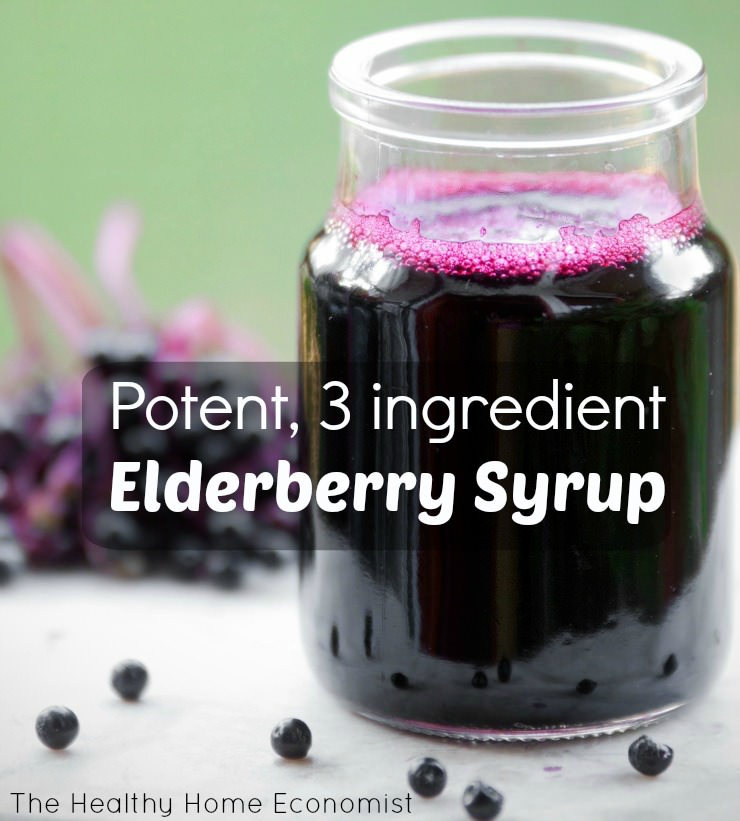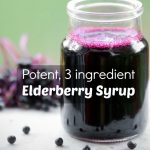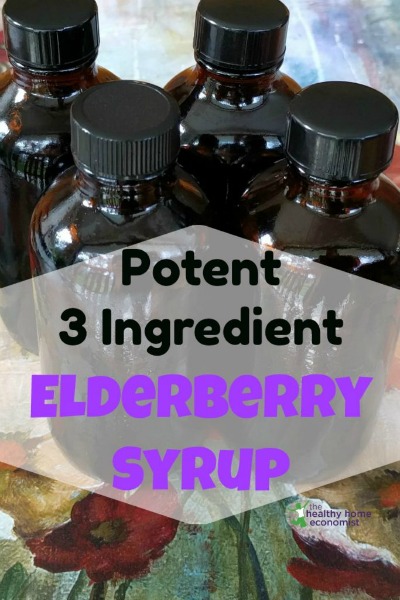
When my children were young and had bad coughs, I relied heavily on elderberry syrup to reduce symptoms.
Small doses throughout the day kept mucous to a minimum which reduced the severity and frequency of coughing spells at night. Unlike some home remedies, this beneficial cold and flu supplement tastes amazing, so they always asked for it. This made my job much easier on busy days.
I never realized until that particular time that this common, nondescript little berry, particularly when concentrated into elderberry syrup, packed such a powerful punch when it comes to managing cough symptoms. The fact is, elderberry in many different forms has been used in folk medicine for centuries to treat flu, colds, and sinusitis as well as coughs.
When I was first introduced to this remedy, I purchased the syrup from our family chiropractor. It was pricey, but definitely worth it especially for my youngest child, who was only 15 months at the time.
I have since learned that it is extremely easy and cost-effective to make elderberry syrup yourself.
Before we launch into a recipe, let’s overview the benefits of elderberry as outlined in the scientific literature.
Elderberry Syrup Benefits in Scientific Literature
Elderberry syrup is not just good for when you are sick either. It is a highly effective preventative too as it is loaded with antioxidants, Vitamin C and immune-supporting minerals.
Scientific research is supportive of the use of elderberries for illness. In one study, elderberry extract inhibited several strains of influenza and reduced symptoms. Another study found that elderberry syrup flavonoids were effective against the H1N1 (Swine Flu) virus.
In the most compelling study, a randomized trial of 60 patients aged 18-54 suffering from flu symptoms for 48 hours or less received 15 ml (3 teaspoons) of elderberry syrup or a placebo 4x per day for five days. Researchers observed that “Symptoms were relieved on average 4 days earlier and the use of rescue medication was significantly less in those receiving elderberry extract compared with placebo”.
Besides being effective at preventing and reducing symptoms, elderberry syrup also has highly practical applications as well. It is delicious on pancakes and waffles or drizzled on homemade ice cream as a sore throat remedy when something cold is especially welcome.
In addition, elderberry syrup can help get less appealing whole food supplements like cod liver oil down the hatch for your little ones.
Tip: A teaspoon of elderberry syrup is a fantastic chaser after the daily dose of cod liver oil. If your kids dislike the taste of cod liver oil, a spoon of elderberry syrup afterward will placate them. It is a tasty treat that will quickly eliminate any aftertaste and help prevent fishy burps.
I would recommend making a batch of this elderberry syrup and having on hand all year long. It is helpful anytime colds, flu and coughs are making the rounds in your household. It is a great supplement to use at the start of the school year too!
Suggested Dosage
A single teaspoon of homemade elderberry syrup once or twice a day is sufficient as a preventative measure. If illness strikes, use more as necessary, with up to 3 teaspoons, 4x per day as used in the randomized study described above.
Please note that because of its potency, homemade elderberry syrup can bring on loose stools in some children and adults. This is not a problem and actually part of the detoxification and healing process of the elderberries. If the stools become too loose for your comfort level, back off the dosage a bit.
Babies and Children Under Age 1
For young children, half the maximum dosage is recommended. In addition, replace the raw honey in the recipe below with date syrup. This traditional whole sweetener is highly nutritious, is safe for very young children and possesses anti-bacterial properties similar to raw honey according to recent research.
This recipe for elderberry jello shots is a great way for little ones on solid food to take their daily dose.
Is Elderberry Safe for Pregnant and Breastfeeding Women?
Surveys indicate that many women use elderberry syrup during pregnancy and breastfeeding. However, there is currently not enough scientific evidence one way or the other to conclusively recommend it.
The journal Frontiers in Pharmacology suggests that “due to lack of evidence of efficacy and safety, health care personnel should not advice (sic) pregnant women to use echinacea or elderberry against upper respiratory tract infection.”
How to Make Elderberry Syrup
The simple elderberry syrup recipe below contains only 3 ingredients: elderberries, raw honey and water. While any type of raw honey is fine for this recipe, manuka honey that is UMF certified 10+ is the most potent type. A single batch is enough to take your family through an entire cold and flu season.
Hint: start giving it to your children a few days before school starts! This recipe is BOTH anti-viral and anti-bacterial.

Simple Homemade Elderberry Syrup Recipe
This 3 ingredient elderberry syrup is simple and fast to make and uses raw honey to boost healing and antibiotic properties.
Ingredients
- 3 cups filtered water
- 1.5 cups raw honey preferably local
- 1.5 cups dried elderberries (or 2-3 cups fresh) preferably organic
Instructions
-
Place dried elderberries (or fresh, ripe elderberries if you have them locally) and filtered water in a medium saucepan.
-
Bring to a boil, reduce heat, and simmer on medium-low for 30 minutes. The liquid will reduce by about one-third.
-
Remove pan from heat and mash the elderberries to release any remaining juice.
-
Strain the mixture into a glass bowl using a cheesecloth (I use these).
-
When the liquid has come to body temperature or lower (about 30 minutes), gently stir in the raw honey and mix thoroughly. Check the syrup with a digital food thermometer to be sure it is lower than 118 F/ 48 C. Any higher will destroy the antibiotic properties of the raw honey.
-
Store and label in small, glass, amber bottles (I use these). See the picture above.
Recipe Video
Recipe Notes
The amounts listed above make a potent syrup that is optimal for serious conditions like flu and bronchitis. For a thinner syrup that is suitable as a preventative and great for minor illnesses like colds, use these measurements:
- 1/2-3/4 cups elderberries
- 3 cups filtered water
- 3/4 – 1 cup honey
Substitute date syrup for the raw honey if making this syrup for children under the age of 1. This brand is recommended.
It is very important to allow the syrup to cool before stirring in the raw honey (or date syrup) else the heat will destroy the antibiotic properties. Raw manuka honey is the most potent honey to use for this syrup (this is the brand I use). But it is also quite strong tasting. A sweeter local honey may be more accepted by your children!
This mixture will last many months in the refrigerator. A cool, dark pantry is also a great place to store it. The raw honey acts as a natural preservative.
Please do not make this recipe with the juice of pressed, raw elderberries. Raw elderberry syrup is a big no-no for the reasons cited in the linked article. Raw is not always better!
Commercial vs Homemade
If after reviewing the elderberry syrup recipe above, you decide that making it won’t be an option at this time, buying it is an option. Commercial brands are not as potent or effective as homemade elderberry syrup made with raw honey.
Raw honey is a natural antibiotic, adding to the strong anti-inflammatory benefits of elderberries.
Commercially made syrups are watered down compared with making it yourself. You can taste the difference in strength if you compare the two. However, they can definitely be used in a pinch (this brand is one of the best).
Once you have all the quality ingredients on hand, you can make a batch of syrup with fresh or dried elderberries at that time.
Making Syrup from Elderberry Juice
A new option for making no-cook elderberry syrup has recently become available. The method uses concentrated elderberry juice instead of dried or fresh berries.
There are a couple of brands I’ve examined that look acceptable (this brand is the best in my opinion).
You simply blend in raw honey to taste and have syrup in a matter of minutes instead of cooking the berries. It is a good option for those pressed for time. However, going this route is a bit more expensive.
Be sure to avoid brands that dilute the elderberry juice with more than small amounts of water or blend in cheaper juices like apple and grape. Read labels carefully!
References
(1) Elderberry Extract Inhibits Several Strains of Influenza
(2) Elderberry Flavonoids bind to and prevent H1N1 Infection in Vitro
(3) Randomized Study of the Efficacy and Safety of Oral Elderberry Extract
More Information
Fire Cider Master Tonic: Natural Flu Anti-viral
The Best Vegetables for Boosting Immunity
Top 10 Ways to Boost Immunity









I steamed/juiced my elderberrys and froze juice. Can I use it and what would the appropriate amounts be? Thanks in advance.
Not sure … have never tried this before! Let us know if you try it and what proportions worked for you.
I followed the recipe exactly–using the source links for dried elderberries and 8oz amber glass jars. I only got 3 – 8 oz jars out of it. What am I doing wrong?
How long did you boil down the syrup? The recipe calls for 1 cup of honey and 3 cups of water so you should get approximately 6-8 jars unless you boiled a lot of water off during the simmer step?
I simmered it for thirty minutes. Kept a careful watch–it was a low simmer. 6 or 8 bottles would be 48 to 64 liquid ounces. Three cups of water and one of honey would be 32 ounces, or 4 bottles. You would lose some water through simmering and then straining out the reconstituted berries.
So, while the math seemed right for the three bottles I wound up with…I was trying to understand how 6-8 bottles would be possible?
When I wrote down my recipe, I must have figured it using the 4 oz bottles. Glad it all turned out for you then!
Oh, okay…I didn’t think of smaller bottles. I thought I was missing something. And thanks for a wonderful recipe. It’s already helped my husband with his seasonal sniffles.
Sorry for the dumb math mistake 🙂 Glad it is working for you already!
Love these kind of recipes. Thanks for this! I picked up dried elderberries from the food co-op in bulk and used my local raw honey and made syrup this morning – very easy. I hadn’t had a cold in a couple years and just got one this past weekend. So great to have this for the future and also for the cold I’m getting over (kinda forgot how miserable a cold can be).
I add fresh lemon juice to increase the vitamin C. I like this recipe because I am not a fan of the “spiced” version. I add elderberry syrup to sparkling water. So yummy and refreshing! They use it all over in Europe, in German called hollunderbeeren (berries) or hollunderblumen (flowers).
I made this today but it’s very thin. How thick should the syrup be?
It really does vary from batch to batch and also the consistency and thickness of the raw honey will affect it as well. Next time, boil it down a bit before adding the raw honey if you like it thicker.
Thank you! My son woke up with a cold town daus after I made this. Between the elderberry, fclo, and essential oils the cold was gone by the very next day!
I am definitely doing this one. Such a nice and simple recipe, plus I know it will help with my sinus problems.
Thanks for sharing.
Hope to make some tomorrow
U suggest taking daily, I’ve also read to only take at 1st sign of sickness, why is this?
I think the volume conversion from dried amounts of 1/2c – 3/4 cup dried to 1 cup of fresh are not accurate. When fresh fruit is dried it shrinks significantly. Minimum of 4x the volume, often shrinkage in volume and weight is 10X. I see what goes in my dehydrator compared to what comes out over the last 15 years I have been dehydrating portions of my harvest. Using only 1 cup of fresh will yield a weak watery version.
Thanks for the recipe – I will have it soon! My children don’t mind the taste of CLO (as you mentioned in the comments) either but it would be great for a preventative! Thanks!